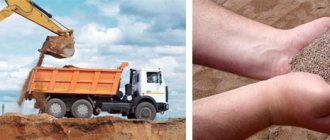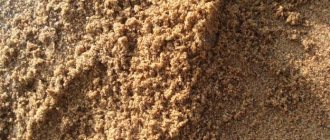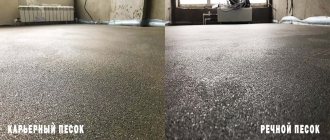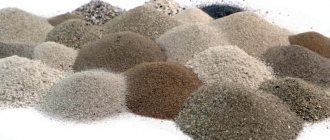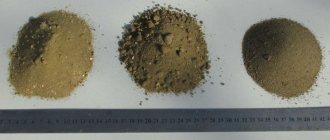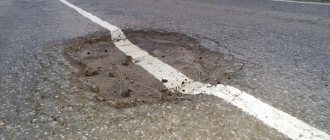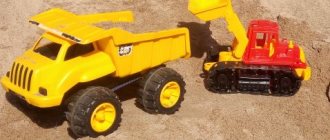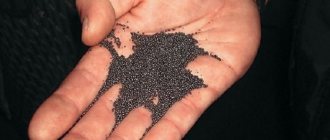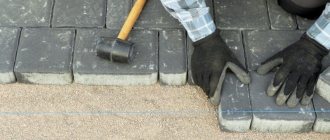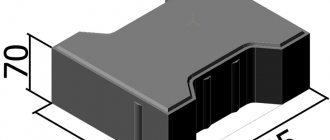Which version of sand is suitable for plaster?
A good plaster mass is not only excellent mechanical properties, it is a whole complex of properties, and all of them are important for the high quality of the coating. To prepare the solution you can use:
- Ready-made dry mixture type SM99;
- A mixture of cement and simple quarry or river sand;
- Plaster based on purified and specially treated mineral grain.
Important! For large volumes of plastering work, it is more economically profitable to prepare the plaster solution yourself from cement and sand filler.
For small volumes, you can use a ready-made mixture and not lose on the quality of the sand ingredient.
What does it consist of?
The main feature of the composition of such plaster is inclusions of fine river sand. Other components are binders, a solvent, and various antiseptic additives to prevent the formation of mold and mildew.
For textural variety, along with quartz sand, mother-of-pearl chips, crushed shell rock or other minerals are added.
In appearance, plaster can be matte or pearlescent. The second group of compositions contains reflective particles, due to which, when rays hit at a certain angle, the surface acquires a pearlescent effect.
Selecting sand for the desired type of plaster
Most experts consider the most rigid and durable mortar based on quarry sand mass. There is a certain amount of truth in this. But high strength is not always the main advantage of finishing building materials.
Raw quarry sand, like most man-made rock crushing products, is cheaper and more readily available. Both river and quarry versions of sand filler have a lot of features that can affect the quality of the plaster in completely different ways.
What are the benefits of using river sand for plaster?
River sand grains are highly homogeneous; they almost always have high roughness, round shape and stable size. The grain size of such material largely depends on the place of its extraction and can be large or medium fraction. The ratio and spread of grain sizes within one batch is almost unchanged. River sand is ideal for high-quality plaster, which has excellent sound and thermal insulation. Plaster based on material from the river perfectly allows air and water vapor to pass through. The density of such plaster is lower than for plaster mixtures based on quarry sand or an artificial product. This plaster has the best plastic characteristics and is easily applied to the prepared surface.
Due to the specific properties of the surface of rounded grains of river material, cement grains “stick together” with the sand mass much more easily during the hydration process. But plaster mortar based on cement and river material adheres much worse to an unprepared wall surface. The medium and fine fraction of river sand is better suited for putty material than quarry sand filler. Plaster mortar on river filler, prepared with excess cement content, will not lead to the development of cracks.
Using quarry sand
The composition of the mountain sand mass differs greatly, depending on the place of extraction, in the content of undesirable impurities, such as metal oxides, complex silicon salts and, above all, clay. In the composition of quarry material, the grains have sharp edges, and most importantly, the grain size ratio is very different. One mass is full of both large and small grains, so dry quarry material has a higher bulk density.
Plaster on sand from a quarry will be much denser and heavier than mortar on river material with the same ratio of components. The quarry option is well suited for preparing a plaster solution used for spraying - the first primer layer for walls, on which all subsequent layers are laid.
The grains of quarry sand filler have sharp edges, which make it possible to perfectly hold the plaster solution on a brick or even concrete wall surface. In some cases, quarry sand is washed to remove clay and the shape of the grains is changed by special treatment, making them flatter and sharper. This filler has increased adhesion to concrete and is often used as a filler for primers called concrete contact.
Clay-free, but not graded, quarry grain is ideal for heavy concrete castings or masonry mortar. This building material has a rigid character and holds the geometry of the wall masonry well. In a plaster solution, it can be added in a higher ratio; this will not reduce the mechanical properties, but may increase cracking.
Fractionated, washed sand from a quarry can be used for plastering in the same way as regular river sand, provided that additional polymer additives based on acrylic resins or polyvinyl acetate emulsion are used. Large fractions are practically unsuitable for interior plastering of walls.
Which sand is better: quarry or river sand?
Which sand is better - quarry or river - this question does not have a clear answer. There are several arguments in favor of one or the other, and it is difficult to understand the truth. You can often hear from an experienced builder positive comments in the direction of, say, river sand. But there will always be a professional who will advertise quarry sand without commercial interest. It’s difficult to understand, especially if you have no experience in construction and this is your first time encountering something like this. But some conclusions can be drawn. In fact, there is an answer to the question of which sand is better: quarry or river sand. Only he is not in the singular, but in the plural, and speaks in favor of one variety and in favor of another.
Quarry sand will always contain impurities of dust, clay or soil after mining. Even a small amount of these impurities negatively affects the quality of concrete or cement mortar. River or sea sand does not have such additives, or it does, but in very small and imperceptible quantities. The water washed away such sands, making them clean.
River sand (or sea sand) was in the water for a certain time. Due to this stay and the friction of the grains of sand among themselves, they acquired a smoother surface. With fine river sand this is not visible to the naked eye. But when magnified many times, the grains of sand literally look like glossy pellets. Accordingly, the adhesion of sand and cement in the solution will be weaker. Again, this may not be visible visually and will require laboratory intervention, but it will definitely show the result: quarry sand is more preferable where special strength of the concrete structure is required.
Sometimes there is a situation where artificial sand, which was obtained by crushing rock, is sold under the name “quarry” sand. Such sand is quite suitable for use, but the huge amount of too small particles makes the concrete not as strong as we would like. Additional sifting helps to partially solve this problem.
For plastering walls or other surfaces, a more ideal result is obtained when using quarry sand. It is smaller than the river one and it is the difference in factionality that gives such a high result.
River or sea sand, due to its large grains, is more suitable for pouring concrete blocks, foundations, plinths, blind areas or other similar structures. The presence of reinforced frames only increases strength, making concrete products very reliable and durable.
For laying small blocks or bricks, it is better to use quarry sand. A solution based on it will be more plastic than when using a river analogue. If the blocks are large, for example, cinder block or shell rock, then river and sea sand will be more preferable.
When constructing sand cushions (before pouring the foundations), it is more advisable to use quarry sand. It lays down more densely and does not shrink as much as can be observed in the case of river sand.
For the production of paving slabs, you can choose both types of sand. But if the choice fell on quarry sand, then it is advisable to wash it for tiles. Any structure that will have direct contact with water or snow should be made of concrete with the least amount of unnecessary impurities. And in this case, the concept of “unnecessary” can be replaced with “harmful”. Clay and soil in quarry sand can simply be washed away with water. Within a few years, the entire structure simply crumbles into separate pieces.
Special types of sand for plasters
A large number of components for concrete or plaster mixtures are produced from crushed rock waste. After grinding, washing and fractionation, heavy granules with grains of arbitrary shape are obtained.
The adhesion of such grains to the cement grain is not always uniform and can cause significant shrinkage. Therefore, for plastering work, such sand filler is subjected to thermal hardening, which increases the roughness and surface area of the grains. In some cases, artificial sand is treated with dry powder adhesives, which increase adhesion to the base, even in conditions of low water content in the solution.
High-quality rock sand is perfect for any plaster; it is very often used instead of expensive quartz sand in a variety of ready-made cement-based mixtures. It is better not to use sand of unknown origin for household work due to the possible unfavorable environmental content of the material.
Completion
Any of the available product options can be used in plastering walls. For soil and spray it is better to use quarry sand; for subsequent layers of wall plaster, experts advise using building materials from the river.
For exterior finishing, filler from a quarry will be more preferable, provided that at least part of the clay and rock is washed and removed. The finest fraction of river filler is ideal for making homemade putty from acrylic water-soluble paint and glue.
Sometimes, in order to equalize the overall characteristics, mixes of different versions of sand filler are used. This will make it possible not to depend on the individual characteristics of one of the sands and reduce the cost of production of cement-based wall finishing materials.
- Composition and proportions of mortar for bricklaying
- How to make colored brick mortar
- Size and weight of white sand-lime brick
- Silicate facing brick
Plastering surfaces is an integral part of finishing a room. The final result of the repair depends on how well it is done. If you do all the work yourself, you should know which sand is best for plastering walls.
Choosing a filler for plastering walls
Sand can be called a universal material, as it has found its application in all construction work. As you know, it can be river or quarry. Experts differ on the issue of choosing the right sand for plastering. Some say that river water is preferable, since it does not contain foreign impurities, clay and foreign debris. This results in a better quality solution and stronger adhesion to the wall surface. Others believe that the presence of clay particles in the quarry material gives the mixture plasticity, so it is easier to apply to the base. If you are doing ordinary renovations in an apartment, then quarry filler is quite suitable. It turns out that one type of filler makes the solution durable, and the other makes it easy to use. Which one you should choose, decide for yourself depending on your needs.
It is strongly recommended not to use sand filler that contains dust, clay and silty impurities. It should be free of lumps and clean. To do this, the material must first be sifted.
Quarry and river sand
The choice of filler depends on the thickness of the layer to be applied.
For finishing work with a thin layer, it is best to use river sand. Compared to other types of this material, it is environmentally friendly. It is extracted from the river bottom by a dredge. This sand aggregate contains no clay grains and virtually no stones. With an average size of up to 2.2 mm, it does not shrink, which makes it possible to use it for plastering walls and masonry.
If rough finishing of the walls with a thick layer is intended, then material of river origin is not recommended. As a result of many years of exposure to water, the sharp edges on the grains of sand have been erased. And therefore it consists of small smooth balls that do not adhere well to the base and to each other.
Quarry sand can provide a stronger coating with good adhesion. This ensures a long service life of the finish. It owes its origin to weathering. Quarry sand is formed from quartz rocks, mica and feldspar. It is mined by open-pit mining from rocks. The cost of such filler is significantly lower than river filler. When purchasing plastering material, be sure to check whether it has been washed or cleaned.
Types of filler for cement-sand mortar
Sand aggregate is divided into types according to the size of grain fractions:
- coarse-grained with grain size from 2 to 4 mm;
- medium fraction with grain size from 0.5 to 2 mm;
- fine-grained with grain size from 0.25 to 0.5 mm.
To plaster walls with your own hands with a cement-sand mortar, medium-fraction sand is usually used. It must be of high quality, without impurities. How uniformly and smoothly the layer will lie depends on the size of the sand grains. The smaller they are, the easier it will be for you to work with the solution. It is perfect for finishing leveling floors or walls. For the first (rough) layer of plaster, coarse sand is used. To prepare the plaster mortar, it is worth purchasing already cleaned and sifted sand.
It is important to know that even with high roughness, the finer it is, the greater the amount of binders and water needed to envelop it.
How to sift sand correctly?
To properly and efficiently sift the material for cement-sand mortar, you will need a large sieve or a wooden frame on which you can stretch a mosquito net. If the volume of sand filler is small, then a regular piece of unnecessary tulle is quite suitable. Sand for preparing mortar for plastering walls must be dry. But if it contains clay impurities, then it must be washed and then wait until it dries completely.
- Place the sieve on the container into which the sand will be poured.
- Pour the sand slowly in the form of a slide and then it will sort itself by size. The smallest one will be at the top. It's great for grouting.
- You must throw the sand filler with a shovel yourself. With this method, fine sand will lie closest, larger sand will fall farther away, and the pebbles will fly to the side.
- If there is wind, you can use its help. In this case, sand is poured out from a slightly raised container or thrown upward with a shovel. The small one will be the furthest away.
GOST standards
Not only various products, but also natural materials are subject to standards and regulations. To find out whether sand quarry filler meets GOST requirements, there are various tests.
The grain composition of the sand filler is determined according to GOST 8736-93. To do this, it is sifted through sieves having cells of different sizes: 0.16; 0.315; 0.63; 1.25; 2.5 and 5 mm.
The resistance of sand to the influence of alkalis is also determined. This requirement must be taken into account when producing concrete. There is a list of minerals that cannot be used for building mixtures.
According to GOST 8735, quarry construction sand is always treated with NaOH (sodium hydroxide) solution for testing. This is a test for the presence of organic impurities. As a result of the test, he will not change the color of the mixture to a darker one or one that matches the sample.
Cost of sand aggregate for plaster
When making renovations, people usually try to immediately make an estimate of the costs of purchasing building materials. The cost of sand is relatively low, but when taking into account all the costs, one should not forget about the investment in its purchase.
You should know that the higher the price of the material, the more actions were done with it during washing and extraction. One of the economical options would be a quarry that has not been washed or seeded. Its cost per 1 m3 ranges from 350 to 450 rubles. Sand filler sifted or purified with water for construction work will cost from 600 to 750 rubles per 1 m3 + delivery.
The cost of river sand is much higher than that of quarry sand. The cost of purchasing it will range from 800 to 1000 rubles per 1 m3.
The most expensive material is fractionated quartz filler. Buying from 10 tons with delivery will cost approximately 4800 rubles per 1 m3.
The sand mass is one of the main components of the plaster mortar. If with regard to the second component - cement, it is still possible to obtain certain information about how its brand will influence the main characteristics of the plaster, then with regard to sand the situation is much more complicated. There is practically no reliable information about what kind of sand is needed for plastering walls. There are only conditional recommendations from technologists on the shrinkage of concrete materials, so the question of which sand is best for plastering walls is often decided based on their own experience and practice.
Types of sand used in construction
It is clear that no special version of sand is used to prepare the plaster mass. In the best case, sand concrete for plastering walls is prepared on the basis of a washed sand mixture purchased specifically for finishing work. In the worst case scenario, sand taken from a nearby ravine or construction site is added to the plaster.
According to standards, sand is divided into four size groups:
- Large sowing, grain size on the sieve cell from 2 mm to 3.5 mm. Such sand is almost always classified as washed river sand, since it is quite difficult to find a clean coarse fraction in quarries;
- Medium sowing, grains of sand measuring 0.5 -2 mm. Such sand can be obtained as a tailing fraction after washing river material or from quarries adjacent to the river floodplain;
- Small fraction, size should be within the range of 0.25-0.5 mm. As a rule, this is the “tail” after washing the quarry sand;
- Quartz sand, selected from individual layers of the quarry, is the most expensive and rare, and is used as a filler for special adhesive primers, adhesives, repair compounds, plasters and self-leveling floors.
For your information! Quarry sand is considered to be the dirtiest due to the large number of inclusions, primarily clay and soil masses. But this does not mean that it is not suitable for plastering work.
It is clear that the above classification, even if it is defined by GOST or SNiP, is a technological concept. Information about the size of sand will not help in any way to determine the optimal ratio of cement and sand for plastering walls. The size and shape of sand grains are needed in large factories for the production of finished reinforced concrete products.
Decorative plaster silk
This composition contains cellulose and cotton fibers. The mixture turns out dry, and to give the effect of a silk coating, manufacturers add artificial silk particles.
The finished coating is a surface where the contained silk particles shimmer and shimmer, creating a certain gloss.
The presented texture has a number of advantages of its use:
- its application is allowed on any surface;
- such decorative plaster can hide flaws;
- quite economical use, since the layer is only up to 2 mm thick;
- the coating can stretch up to 5 mm, so it can be used for renovations in a new house, which only shrinks;
- If one area is damaged, it can be easily restored by diluting a small amount of dry mixture.
Of course, there are some negative aspects: although such finishing is economical, the plaster itself has a cost that is a little unaffordable for the average person.
If you decide to create a beautiful and high-quality interior, then you should not save on money.
How is quarry sand worse than river sand?
The extraction of sandy material in a quarry is always accompanied by severe contamination of the sand with foreign inclusions. While large pieces of soil and rock can still be removed by screening, small lumps of clay and loam always remain in the sandy mass. Clay increases the plasticity of plaster, but often clay inclusions cause increased shrinkage of the material and cracking of the plaster layer.
In essence, the grains of quarry material are microscopic prisms or crystals with very sharp edges, which is the main cause of shrinkage. Even with pure quarry mass, cement mortar for plastering walls shrinks by 1 mm per 1 cm of thickness of the laid mass.
The most negative factor is that quarry sands usually become a sponge or a filter that collects the entire periodic table from toxic chemicals to heavy metals. Therefore, it will be useful to fill sand purchased from a quarry with water and add a small amount of alkali. If the sand has darkened, the material will need to be washed at least three times.
The best river sand can be found on a wild beach or sand spit. This sand has stable grain sizes and, most importantly, contains a minimal amount of organic substances, which are very difficult to remove from the mass. Before putting silted sand into the plaster solution, it is best to treat it with a small amount of alkali or a very weak solution of hydrochloric acid, calcinate it or dry it in the sun. The dried sand cake is broken into pieces and ground with a tamper until it becomes free-flowing.
Features of quarry sand
Based on the name, it is clear that this type of sand is mined in quarries. Initially, in its raw form, it is not distinguished by its purity. It contains impurities (dust, stones, clay, etc.), its grains of sand have a rough shape, they are larger than those of river sand.
Here are the characteristics of quarry sand in accordance with GOST 8736-2014:
- impurities – 3-10%;
- average grain size – 2-5 mm;
- bulk density – 1.47 g/cm3.
There are 2 types of purified quarry sand: seeded and washed. The first is cleaned only by sifting, and the second is also washed. As a result, it is possible to remove most of the unwanted impurities (their amount is reduced to 0-3%), and also to separate the grains of sand according to their fineness modulus, up to 0.1-0.25 mm. Purified sand has a higher filtration coefficient (1.8-3.8 m/day), that is, it will not retain moisture for a long time.
Recommendations for the selection of sand mixtures for plaster
Despite the fact that the process of preparing a plaster mixture for walls is in many ways similar to mixing concrete, there are quite serious differences. Plastering walls requires that several conditions be met at once:
- The mass should have minimal shrinkage with a sufficiently high surface strength;
- The plaster layer must contain a certain number of air pores to ensure vapor permeability of the walls;
- The plaster material must be viscous so as not to drain from the surface of the walls, and at the same time plastic to ensure leveling of the plane.
All of the above qualities are best regulated by adding sand, lime and polymer additives. In addition, proper execution of plaster involves applying several layers to the wall, even if the thickness of the finishing material is relatively small. Ideally, in order to achieve good wall permeability and at the same time high strength of the plaster material, you will need to select your own version of sand for each layer of plaster.
Sand for cement plasters
Manufacturers of ready-mixed building mixtures have been successfully using this principle for a long time, offering several types of plastering materials, from starting to super-finishing. If you need to make plaster for the walls of a house, it makes sense to use the same principle.
It is generally accepted that the best sand option for home plastering is river sand; it provides a large number of air pores, which means minimal shrinkage on the walls and good vapor permeability. In practice, plaster on river sand turns out to be flexible and light, but sticks very poorly to the wall. You can still lay a thin layer of plaster on a brick wall sprayed with cement laitance; on concrete, “river” plaster is laid only with preliminary priming with concrete contact.
For the first layer of plaster, it is best to prepare a mixture based on washed and seasoned quarry sand. If it is intended to lay a relatively thick layer of plaster, then the sand from the ravine must be subjected to additional cleaning and fractionation in the following order:
- We remove large debris, stones and grass through a large mesh, sift out small lumps of clay on a mesh with a mesh size of 4-5 mm;
- Soak the sand in a barrel for 4-5 hours, it is best to combine soaking with periodic stirring of the mass so that the clay dissolves in water;
- Drain the dirty water and fill it with clean water. Having thoroughly shaken the sand mass in four times the volume of water, pour the top into a second container and set aside.
For your information! What has settled in the second container is best suited for the starting layer of plaster; the remainder in the first barrel can be used for the second pass.
For the finishing mass of plaster, it is still better to take river sand, rinse without fractionation, in stagnant water, with a small addition of detergent. The raw mass is crushed to avoid the formation of lumps of sand and rubbed with cement according to the standard recipe for plastering walls.
Clay and lime plaster
Clay plaster with the addition of organic fibers and lime has recently become increasingly fashionable for finishing indoor walls. In addition to a healthier environment, walls finished with clay provide a specific microclimate that is more suitable for people with allergic diseases.
It is best to knead on unwashed river sand for thin clay. Fat plastic clays are mixed using quarry material. The selection of the optimal ratio of components largely depends on the quality of the materials, so it is quite difficult to offer exact proportions. The technology for preparing and applying plaster to walls is similar to cement mixtures; for the finishing layer you will need to add a small amount of lime paste.

